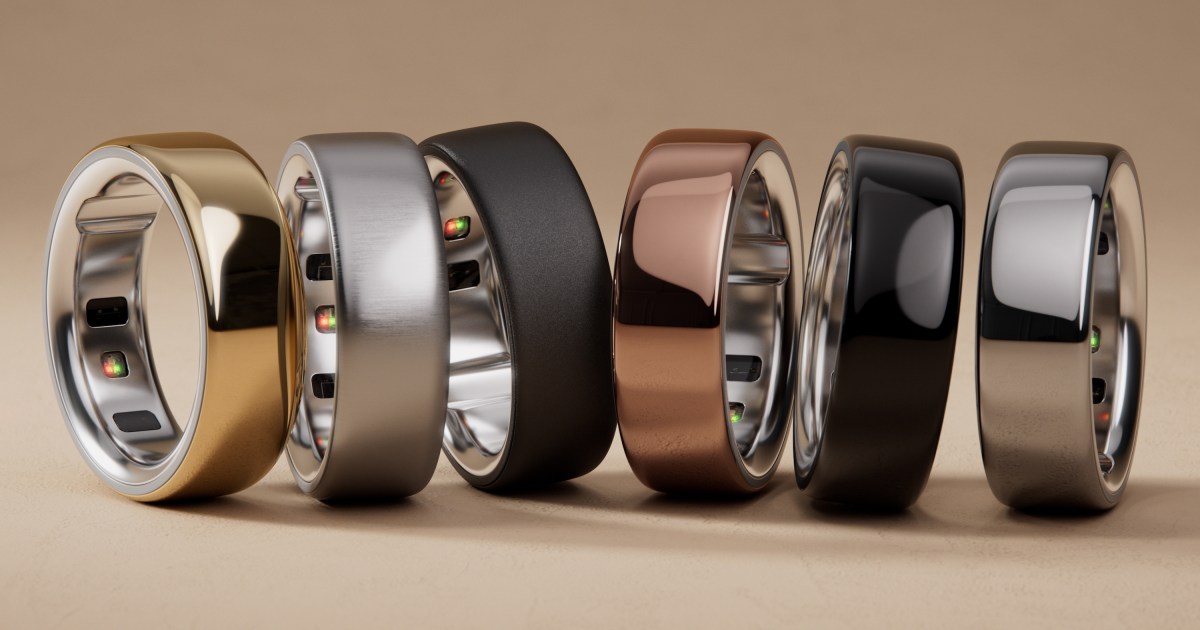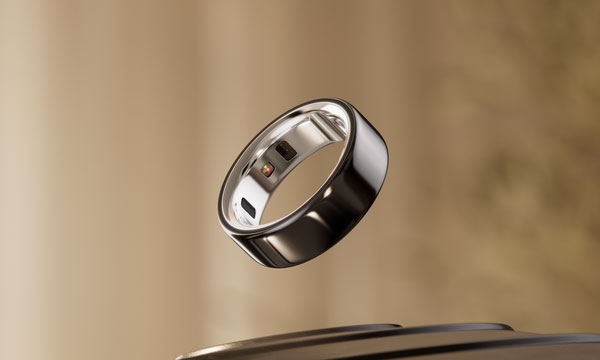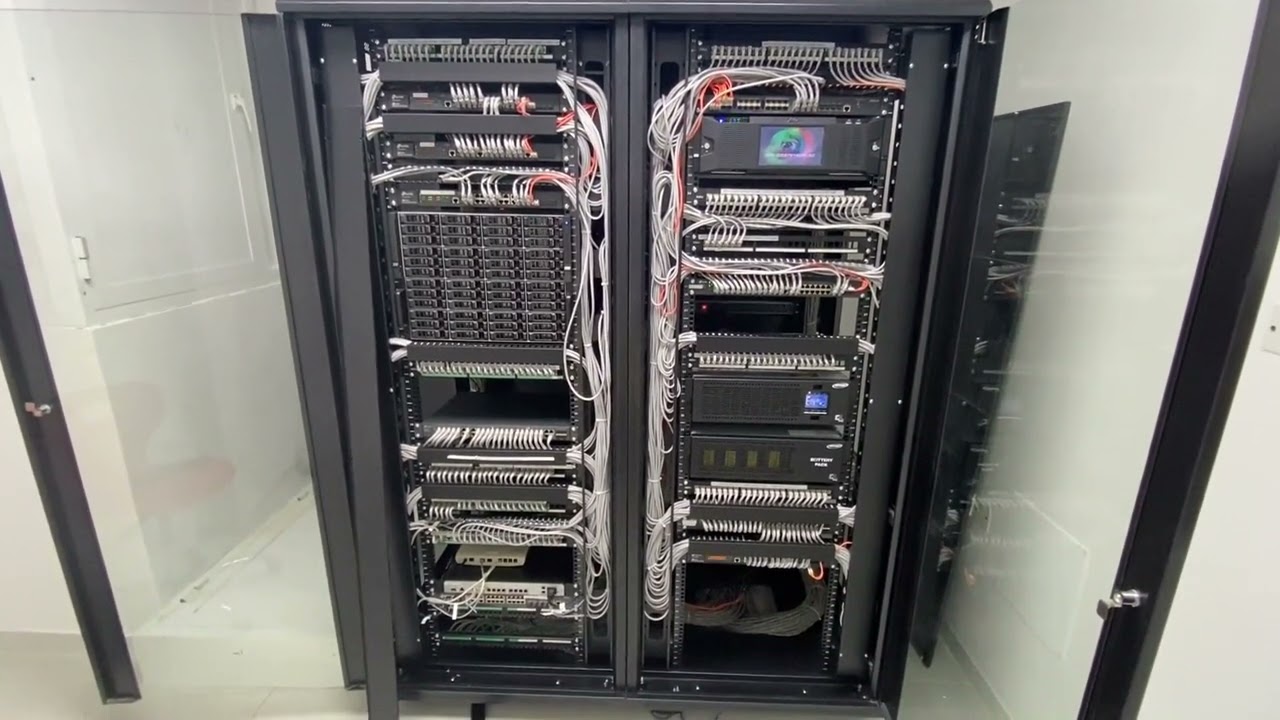Technology
The Oura Ring 4 smart ring is here, and it looks superb

Following the release of various other new smart rings this year, Oura has announced the Oura Ring 4, the latest generation of probably the best-known smart ring. It comes with a wide range of changes and new features, plus a brand new design.
Prior to the launch, Jason Russell, vice president of consumer software product at Oura, talked to Digital Trends about the ring, giving us some interesting insights into what makes it special.
The Oura Ring 4’s new design

“We have improved the comfort for 24/7 wear, we’ve expanded the size range, improved battery life, and we have this incredible new sensing platform,” Russell told Digital Trends, setting the scene for the critical updates.
The Oura Ring 4 is made of titanium, and this time, the metal extends to the underside of the ring, replacing the epoxy resin used for the previous-0generation models. The dome-like 1.3mm-high nubbins have been removed, and the sensors are practically flat at 0.3mm high, increasing overall comfort. The Oura Ring 4 weighs between 3.3 and 5.2 grams, is 7.9mm wide, and is 2.88mm thick. It’s now available in more sizes, ranging between size 4 and size 15.
It’s available in six different finishes: silver, black, Stealth, gold, rose gold, and brushed silver. The Stealth version has a diamond-like carbon (DLC) coating, while all the others have a physical vapor disposition (PVD) coating for toughness and scratch resistance. However, the underside of the ring isn’t coated, and titanium is hypoallergenic and skin-friendly. The ring has 100 meters of water resistance and is suitable for swimming. Oura claims the battery will last for eight days, up from seven days for the third-generation Oura Ring, and it comes with its own charging plinth, which should recharge a flat battery fully in 80 minutes.
Upgraded sensors with better accuracy

You may be wondering how the recessed sensors have affected accuracy. Russell explained how accuracy has actually been increased with the new design.
“We designed [the dome sensors] five years ago because of their usefulness for accuracy, and we’ve seen many smart ring makers leverage that same design. You also see some that don’t utilize those domes, which really comes at the expense of accuracy. We’re not willing to sacrifice accuracy, and that’s what’s really remarkable about [the Oura Ring 4] as we’ve lowered the domes, not just while maintaining accuracy, but actually making a huge leap forward using a revolutionary new sensing platform called Smart Sensing.”

The Smart Sensing algorithm works with the sensors to gather information across 18 different pathways, up from the eight pathways on the Oura Ring Gen 3. The algorithm dynamically adjusts to find the optimal path for increased accuracy. Oura’s own studies indicate the Smart Sensing platform will return a 120% improvement in blood oxygen sensing, a 15% improvement in breathing disturbance accuracy, and fewer gaps in heart rate recording during the day and night. Russell told Digital Trends that the Oura Ring 4 has new LEDs to go with the new algorithm.
“We really want [the Oura Ring 4] to adapt to you,” Russell continued. “The ring can rotate 30 degrees in either direction, and we can still get a good signal. We address all varieties of finger shape and size and get a good signal on them. The titanium interior is helpful for comfort, but it’s also helping for accuracy as it channels light in a more precise way, as it doesn’t create light diffusion or absorb reflected stray light that could happen with the epoxy material and dome configuration.”
A redesigned Oura app

To go with the new ring design, Oura has also redesigned its companion app.
“We have introduced 24 new features over the last 18 months,” Russell reminded us. “We’re packing a lot in, and it can be overwhelming. We have reorganized the app with that in mind, putting the focus on holistic health and connecting it with short-term metrics used for Readiness and sleep activity and longer-term metrics like cardiovascular age.”
There are three tabs along the bottom of the app: Today, Vitals, and My Health. Notably, shortcut tabs along the top of the Today screen show familiar Readiness, Sleep, Activity, Heart Rate, Stress, and Menstrual Cycle scores, while the main section below shows current biometrics and progress toward your goals. The Vitals screen provides more in-depth data, while the My Health screen has long-term health metrics such as Stress Resilience, Cardio Age, and ongoing trends.
All features will be available for all Oura Ring members
There are some changes to existing features, too. The Activity feature has gained automatic heart rate monitoring for 40 activities, up from just five before, complete with heart rate zone tracking and V02 Max monitoring. The stress monitoring feature now includes daily movement and activities, plus manually added tags, for a more informative overview of your daily condition. Tags can be added to a timeline, along with photos of meals, which the app will categorize automatically for meal tracking.
Russell also mentioned that a fertility window feature will launch soon, and that all features will be available for all Oura Ring members. The new app will be made available to current Oura Ring owners over the coming weeks, and the previously iOS-only Oura Labs feature is now available for Android owners too. Digital Trends also confirmed there is no change to the subscription cost, which remains at $6 per month or $70 per year. The Oura Ring 4 comes with one month’s free access to the app.
Oura Ring 4 price and availability

The Oura Ring 4 starts at $349 and is available for preorder through Oura’s online store today abd will be ready for release on October 15. It’ll also be available through Amazon and in stores including Best Buy, Target, and John Lewis in the U.K. Oura notes that the Oura Ring 3 will continue to be available to purchase until stock runs out, but we’d recommend buying the latest version unless you find it for a considerably lower price. Oura also has a new sizing kit and recommends you use it even if you already own an Oura Ring, as it says Oura Ring 4 sizes may be slightly different.
Its arrival comes after Samsung released the Galaxy Ring, RingConn launched its updated RingConn Gen 2, and Circular made some changes to its Circular Ring Slim. Oura has long been the benchmark for smart rings, and from what we can see at this stage, it has made significant advancements in all areas, from design to accuracy, to help maintain its position with the Oura Ring 4.
Technology
Oura’s return to the smart ring fight

Oura’s next-gen ring appears to be an upgrade in every way. It features a sleeker design, longer battery life and smarter sensors to offer deeper insights for wearers. No more squarish edges; it’s a perfect ring this time. Oura says Ring 4 has 18 signal pathways, up from eight in the Gen3, which is paired with its new Smart Sensing algorithm.
New features include automatic heart rate and activity detection for up to 40 activities. It’ll land in six colors: Silver, Brushed Silver, Gold, Rose Gold, Stealth and Black. All bar the Stealth is made of titanium. Oura Ring 4 is available to pre-order today, with shipping expected to begin on October 15, 2024. Prices start at $349.
— Mat Smith
The biggest stories you might have missed
OpenAI rakes in over $6 billion in new funding
Bose QuietComfort Earbuds review: A more affordable ANC ace
Amazon tablets are getting AI tools, like writing assist and website summaries
Through an Instagram stream and publicly available information.
Two Harvard students used facial recognition tech and a large language model to unearth a subject’s name, occupation and other details. Their setup (dubbed I-XRAY) can use that information to pull data like addresses, phone numbers, family member details and partial social security numbers from various sources online.
In a demo video, AnhPhu Nguyen and Caine Ardayfio used the glasses to address people who appear to be strangers by name, discuss their work and bring up a place where they may have met in the past, based on information picked up. The students told 404 Media they developed I-XRAY to make people aware of what’s possible with current technology — they won’t release the code they used.
The long-awaited SUV is finally here.
Following its first two cars of the same name, the Polestar 3 delivers what many of us were looking for. It’s a mass-market machine to fill the needs and wants of buyers looking for an all-electric SUV with proper dimensions — and yellow seat belts. After all the delays, we’ve got a test drive.
The new minimum price for a Model 3 is $42,500.
Tesla’s Model 3 Standard Range Rear-Wheel Drive is no longer available in its online configurator. Electrek first reported on the absence of the cheapest option from the electric vehicle brand, with a price tag of $39,000. Now the Model 3 with Long-Range Rear-Wheel Drive takes that title with a retail price of $42,500.
Servers computers
Server Rack for sale BD, #server #rack #dhaka
Technology
Inference framework Archon promises to make LLMs quicker, without additional costs

Join our daily and weekly newsletters for the latest updates and exclusive content on industry-leading AI coverage. Learn More
Researchers from Stanford University‘s Scaling Intelligence Lab introduced a new inference framework that could help large language models (LLMs) go through potential responses faster.
The framework, Archon, uses an inference-time architecture search (ITAS) algorithm to improve LLMs performance without additional training. It is model agnostic, open-source and designed to be plug-and-play for large and small models.
Archon could ideally help developers design AI model systems using multiple inference-time techniques to cut down on models to determine responses. The Scaling Intelligence Lab said techniques like Archon would help cut down on costs related to building models and inference. As LLM development turns toward larger parameters or more advanced reasoning, costs could increase despite companies like OpenAI anticipating more affordability.
According to the researchers, Archon automatically designs architectures that improve task generalization, enabling models to perform tasks beyond those they were initially trained on.
“Our Archon framework and ITAS algorithm draw inspiration from neural architectures and neural architecture search, respectively,” the researchers said in their paper. “Archon is constructed of layers of LLMs, in which models in the same layer run in parallel but each later runs sequentially.”
These layers perform different inference-time techniques, “either transforming the number of candidate responses through generation and fusion (like linear transformations) or reducing the number of candidate responses to improve quality (like non-linearities).”
Archon outperformed GPT-4o and Claude 3.5 Sonnet by 15.1 percentage points in benchmark tests such as MT-Bench, Arena-Hard-Auto, Alpaca-2.0 Eval, MixEval, MixEval Hard, MATH and CodeContests. When Archon faced open-source LLMs, it outperformed them by 11.2 percentage points.
Archon components
The ITAS algorithm is comprised of several LLM components and can do inference-time techniques.
The first component is the Generator, which creates possible answers for the model. The second component, the Guser, will take these responses and combine them into one. An example would be if the question posed to a model wants to know the capital of France, the fuser will take the generated responses of “the capital of France is Paris,” France is in Europe,” and turn it to “the capital of France, a country in Europe, is Paris.”
Next, Archon moves to the Ranker component, which ranks the best answers. A Critic component evaluates the ranked answers to determine whether they’re good or bad. The Verifier checks for logic and correctness before moving on to the Unit Test Generator and Evaluator, which do small tests to see if the response works and check the test results.
By building Archon this way, the researchers said the framework improves the quality of LLMs’ responses faster and without additional fine-tuning.
Archon’s limitations
So far, the Archon framework works best with LLMs with 70B parameters or more like Meta’s Code Llama 70B, making it difficult to point to most LLMs right now. The researchers said most of the challenge comes from the smaller model’s limited capabilities to follow instructions due to the smaller context windows.
“When we utilize the Archon architecture with only 7B open-source models, we get a notable decrease of 16%,” in performance, the paper stated.
Smaller models using the Archon framework lagged behind single-turn models by 15.7%.
The Stanford lab also said Archon “is not ideal for tasks that prefer the latency of a single LLM call,” such as chatbots. The framework makes multiple LLM calls because of the different operations it does so single question-and-answer queries won’t benefit from its capabilities. Archon may work better for tasks involving complex instructions like solving equations, programming, or even complicated customer service issues.
Despite its limitations, the researchers behind Archon said they hope it can accelerate the development of high-performing models without requiring more inference and training capital.
Source link
Technology
Instant harkens back to a pre-Google Firebase

Instant wants to recapture some of the magic of the pre-Google-acquisition Firebase by building a modern, Postgres-based open source version of it.
Like the original Firebase, San Francisco-based Instant focuses on giving front-end developers easy access to a real-time database with offline capabilities without the need to manage any of the back-end architecture. The service supports applications written in React, React Native, and vanilla JavaScript. In addition to the database, it also offers tools to manage authentication and permissions, as well as real-time features like shared cursors, presence, and more.
The team recently open sourced the project.
Instant was founded by former roommates Joe Averbukh (CEO) and Stepan Parunashvili, who previously worked at companies like Wit.ai, Facebook, Airbnb, and others.
At Facebook, Averbukh told me, the architecture was set up to ensure that as a front-end engineer, he was able to move quickly. Meanwhile, at Airbnb, the company’s intricate microservices architecture meant it took a long time to try a new idea. “Thankfully, we already had Firebase inside Airbnb, and we could use it for notifications. So we would actually just use Firebase to prototype these ideas — and that was a huge win,” he explained.

Before starting Instant, the co-founders worked on a fitness app, based on Google’s Firebase. While they loved all of the features like optimistic updates and offline mode that Firebase offers out of the box, they missed having access to a relational database since Firebase’s focus is on its NoSQL database.
“You see apps like Figma, Notion, and Linear — they’re winning the market because of this feature set that they have,” Averbukh said. “And we think that basically, in the same way that apps today are much better than apps before, the expectations are going to rise for what people want in their apps. But the reality is, the way that people build these features today is that they have this whole team that’s building all of these sync services.”
At the core of all of this is Aurora, AWS’s relational database service, which is cost-effective and allows Instant to quickly spin up new databases inside of a multi-tenant architecture that still offers strong security guarantees. Averbukh argues that competitors like Supabase have to spin up a new database for every project (and free user), while Instant essentially lives in one large Postgres instance. He also stressed that if a large enterprise customer would sign up for the service, the team could offer them to spin them up a separate database.
On Wednesday, the company announced that it has raised a $3.4 million seed funding round. It’s backed by Y Combinator and SV Angel, as well as prominent angel investors like former Firebase CEO James Tamplin, Paul Graham, Greg Brockman, and Jeff Dean.
Servers computers
42U NETWORK CABINET FULL MANAGEMENT WITH NETWOK SWITCH PATCH CABLE MANAGER FIBER CABLE FULL REVIEW

42U NETWORK CABINET FULL MANAGEMENT WITH NETWOK SWITCH PATCH CABLE MANAGER FIBER CABLE FULL REVIEW
#youtubechannel
#youtube
#youtuber
#youtubers
#subscribe
#youtubevideos
#sub
#youtubevideo
#like
#ultimatedigitalsolutions
#tech lovers
#newtechviedos
#submychannel
#biotime
#dahua
#soundsystem
#networking
#network
#subscribe
#youtubecreator
#youtubecommunity
#follow #video
#securitysystem
#cctv
#networkswitches
#42UNETWORKCABINET .
source
Technology
A Bank of America outage showed customers blanked-out account balances

First, it was Spotify, then Verizon, then PlayStation, and now it’s apparently Bank of America’s turn to have an outage this week. Some customers reported problems accessing their bank accounts on Wednesday, with the balances showing $0 or “—-” instead of what should be there.
“Some mobile and online banking clients experienced an issue accessing their accounts and balance information earlier today,” writes Bank of America media relations executive Matt Card in an email to The Verge. “These technology issues have been fully resolved. We apologize for any inconvenience.”
Reports spiked just before 1PM ET on Downdetector, with posts across X and Reddit from people reporting that their account balances don’t show anything (some mentioned that the amounts they owe, however, appear to be displaying accurately).
We verified this afternoon that the bank’s app was showing customers a notification that “Accounts temporarily unavailable” and that “Some accounts and/or balances are temporarily unavailable,” as reported previously by CNN. Some people have reported their accounts are working or intermittently gaining access to their information, and it’s unclear how many people have been affected. In July, Bank of America said 58 million clients use its “digital capabilities to help manage their financial lives” and that they connected a record 23.4 billion times last year.
There’s no word on what might have caused the problem, but let us know if things are working for you now.
Update, October 3rd: Added updated Bank of America statement.
-

 Womens Workouts1 week ago
Womens Workouts1 week ago3 Day Full Body Women’s Dumbbell Only Workout
-

 Technology2 weeks ago
Technology2 weeks agoWould-be reality TV contestants ‘not looking real’
-

 Science & Environment2 weeks ago
Science & Environment2 weeks agoHow to unsnarl a tangle of threads, according to physics
-

 Science & Environment2 weeks ago
Science & Environment2 weeks agoMaxwell’s demon charges quantum batteries inside of a quantum computer
-

 Science & Environment2 weeks ago
Science & Environment2 weeks agoHyperelastic gel is one of the stretchiest materials known to science
-

 Science & Environment2 weeks ago
Science & Environment2 weeks ago‘Running of the bulls’ festival crowds move like charged particles
-

 News2 weeks ago
News2 weeks agoOur millionaire neighbour blocks us from using public footpath & screams at us in street.. it’s like living in a WARZONE – WordupNews
-

 Science & Environment2 weeks ago
Science & Environment2 weeks agoHow to wrap your mind around the real multiverse
-

 Science & Environment2 weeks ago
Science & Environment2 weeks agoLiquid crystals could improve quantum communication devices
-

 Science & Environment2 weeks ago
Science & Environment2 weeks agoSunlight-trapping device can generate temperatures over 1000°C
-

 Science & Environment2 weeks ago
Science & Environment2 weeks agoITER: Is the world’s biggest fusion experiment dead after new delay to 2035?
-

 Science & Environment2 weeks ago
Science & Environment2 weeks agoPhysicists are grappling with their own reproducibility crisis
-

 Science & Environment2 weeks ago
Science & Environment2 weeks agoQuantum ‘supersolid’ matter stirred using magnets
-

 News2 weeks ago
News2 weeks agoYou’re a Hypocrite, And So Am I
-

 Science & Environment2 weeks ago
Science & Environment2 weeks agoWhy this is a golden age for life to thrive across the universe
-

 Science & Environment2 weeks ago
Science & Environment2 weeks agoQuantum forces used to automatically assemble tiny device
-

 Sport2 weeks ago
Sport2 weeks agoJoshua vs Dubois: Chris Eubank Jr says ‘AJ’ could beat Tyson Fury and any other heavyweight in the world
-

 Science & Environment2 weeks ago
Science & Environment2 weeks agoCaroline Ellison aims to duck prison sentence for role in FTX collapse
-

 Science & Environment2 weeks ago
Science & Environment2 weeks agoNuclear fusion experiment overcomes two key operating hurdles
-

 Science & Environment2 weeks ago
Science & Environment2 weeks agoTime travel sci-fi novel is a rip-roaringly good thought experiment
-

 Science & Environment2 weeks ago
Science & Environment2 weeks agoLaser helps turn an electron into a coil of mass and charge
-

 Science & Environment2 weeks ago
Science & Environment2 weeks agoNerve fibres in the brain could generate quantum entanglement
-
News2 weeks ago
the pick of new debut fiction
-

 CryptoCurrency2 weeks ago
CryptoCurrency2 weeks agoCardano founder to meet Argentina president Javier Milei
-

 News2 weeks ago
News2 weeks agoIsrael strikes Lebanese targets as Hizbollah chief warns of ‘red lines’ crossed
-

 Science & Environment2 weeks ago
Science & Environment2 weeks agoMeet the world's first female male model | 7.30
-

 Womens Workouts2 weeks ago
Womens Workouts2 weeks agoBest Exercises if You Want to Build a Great Physique
-

 News2 weeks ago
News2 weeks agoWhy Is Everyone Excited About These Smart Insoles?
-
Business2 weeks ago
JPMorgan in talks to take over Apple credit card from Goldman Sachs
-

 Science & Environment2 weeks ago
Science & Environment2 weeks agoA slight curve helps rocks make the biggest splash
-

 News2 weeks ago
News2 weeks ago▶️ Media Bias: How They Spin Attack on Hezbollah and Ignore the Reality
-

 Science & Environment2 weeks ago
Science & Environment2 weeks agoQuantum time travel: The experiment to ‘send a particle into the past’
-

 CryptoCurrency2 weeks ago
CryptoCurrency2 weeks agoBitcoin miners steamrolled after electricity thefts, exchange ‘closure’ scam: Asia Express
-

 CryptoCurrency2 weeks ago
CryptoCurrency2 weeks agoDorsey’s ‘marketplace of algorithms’ could fix social media… so why hasn’t it?
-

 Science & Environment2 weeks ago
Science & Environment2 weeks agoA new kind of experiment at the Large Hadron Collider could unravel quantum reality
-

 CryptoCurrency2 weeks ago
CryptoCurrency2 weeks agoDZ Bank partners with Boerse Stuttgart for crypto trading
-

 Science & Environment2 weeks ago
Science & Environment2 weeks agoWhy we need to invoke philosophy to judge bizarre concepts in science
-

 CryptoCurrency2 weeks ago
CryptoCurrency2 weeks agoBitcoin bulls target $64K BTC price hurdle as US stocks eye new record
-

 CryptoCurrency2 weeks ago
CryptoCurrency2 weeks agoLow users, sex predators kill Korean metaverses, 3AC sues Terra: Asia Express
-

 CryptoCurrency2 weeks ago
CryptoCurrency2 weeks agoEthereum is a 'contrarian bet' into 2025, says Bitwise exec
-

 Womens Workouts2 weeks ago
Womens Workouts2 weeks agoEverything a Beginner Needs to Know About Squatting
-

 News2 weeks ago
News2 weeks agoFour dead & 18 injured in horror mass shooting with victims ‘caught in crossfire’ as cops hunt multiple gunmen
-

 Womens Workouts1 week ago
Womens Workouts1 week ago3 Day Full Body Toning Workout for Women
-

 Travel1 week ago
Travel1 week agoDelta signs codeshare agreement with SAS
-

 Politics1 week ago
Politics1 week agoHope, finally? Keir Starmer’s first conference in power – podcast | News
-

 Technology5 days ago
Technology5 days ago‘From a toaster to a server’: UK startup promises 5x ‘speed up without changing a line of code’ as it plans to take on Nvidia, AMD in the generative AI battlefield
-

 Health & fitness2 weeks ago
Health & fitness2 weeks agoThe maps that could hold the secret to curing cancer
-

 CryptoCurrency2 weeks ago
CryptoCurrency2 weeks agoRedStone integrates first oracle price feeds on TON blockchain
-

 Science & Environment2 weeks ago
Science & Environment2 weeks agoFuture of fusion: How the UK’s JET reactor paved the way for ITER
-

 CryptoCurrency2 weeks ago
CryptoCurrency2 weeks agoBlockdaemon mulls 2026 IPO: Report
-

 Sport2 weeks ago
Sport2 weeks agoUFC Edmonton fight card revealed, including Brandon Moreno vs. Amir Albazi headliner
-

 CryptoCurrency2 weeks ago
CryptoCurrency2 weeks agoCoinbase’s cbBTC surges to third-largest wrapped BTC token in just one week
-

 Technology2 weeks ago
Technology2 weeks agoiPhone 15 Pro Max Camera Review: Depth and Reach
-

 News2 weeks ago
News2 weeks agoBrian Tyree Henry on voicing young Megatron, his love for villain roles
-

 Servers computers1 week ago
Servers computers1 week agoWhat are the benefits of Blade servers compared to rack servers?
-

 Health & fitness2 weeks ago
Health & fitness2 weeks agoThe secret to a six pack – and how to keep your washboard abs in 2022
-

 CryptoCurrency2 weeks ago
CryptoCurrency2 weeks agoCrypto scammers orchestrate massive hack on X but barely made $8K
-

 Science & Environment2 weeks ago
Science & Environment2 weeks agoBeing in two places at once could make a quantum battery charge faster
-

 CryptoCurrency2 weeks ago
CryptoCurrency2 weeks agoTelegram bot Banana Gun’s users drained of over $1.9M
-

 CryptoCurrency2 weeks ago
CryptoCurrency2 weeks agoVonMises bought 60 CryptoPunks in a month before the price spiked: NFT Collector
-

 Science & Environment2 weeks ago
Science & Environment2 weeks agoHow one theory ties together everything we know about the universe
-

 Science & Environment2 weeks ago
Science & Environment2 weeks agoUK spurns European invitation to join ITER nuclear fusion project
-

 CryptoCurrency2 weeks ago
CryptoCurrency2 weeks ago‘No matter how bad it gets, there’s a lot going on with NFTs’: 24 Hours of Art, NFT Creator
-

 Science & Environment2 weeks ago
Science & Environment2 weeks agoHow do you recycle a nuclear fusion reactor? We’re about to find out
-

 CryptoCurrency2 weeks ago
CryptoCurrency2 weeks agoSEC asks court for four months to produce documents for Coinbase
-

 Science & Environment2 weeks ago
Science & Environment2 weeks agoTiny magnet could help measure gravity on the quantum scale
-
Business2 weeks ago
How Labour donor’s largesse tarnished government’s squeaky clean image
-

 News2 weeks ago
News2 weeks agoBrian Tyree Henry on voicing young Megatron, his love for villain roles
-

 Womens Workouts2 weeks ago
Womens Workouts2 weeks agoHow Heat Affects Your Body During Exercise
-

 Womens Workouts2 weeks ago
Womens Workouts2 weeks agoKeep Your Goals on Track This Season
-

 Science & Environment2 weeks ago
Science & Environment2 weeks agoCNN TÜRK – 🔴 Canlı Yayın ᴴᴰ – Canlı TV izle
-

 Technology1 week ago
Technology1 week agoRobo-tuna reveals how foldable fins help the speedy fish manoeuvre
-

 Science & Environment1 week ago
Science & Environment1 week agoX-rays reveal half-billion-year-old insect ancestor
-

 Politics2 weeks ago
Politics2 weeks agoTrump says he will meet with Indian Prime Minister Narendra Modi next week
-

 CryptoCurrency2 weeks ago
CryptoCurrency2 weeks agoLouisiana takes first crypto payment over Bitcoin Lightning
-

 CryptoCurrency2 weeks ago
CryptoCurrency2 weeks ago$12.1M fraud suspect with ‘new face’ arrested, crypto scam boiler rooms busted: Asia Express
-

 CryptoCurrency2 weeks ago
CryptoCurrency2 weeks agoDecentraland X account hacked, phishing scam targets MANA airdrop
-

 CryptoCurrency2 weeks ago
CryptoCurrency2 weeks agoBitcoin price hits $62.6K as Fed 'crisis' move sparks US stocks warning
-

 CryptoCurrency2 weeks ago
CryptoCurrency2 weeks agoCertiK Ventures discloses $45M investment plan to boost Web3
-

 CryptoCurrency2 weeks ago
CryptoCurrency2 weeks agoBeat crypto airdrop bots, Illuvium’s new features coming, PGA Tour Rise: Web3 Gamer
-

 Science & Environment2 weeks ago
Science & Environment2 weeks agoA tale of two mysteries: ghostly neutrinos and the proton decay puzzle
-

 News2 weeks ago
News2 weeks agoChurch same-sex split affecting bishop appointments
-

 CryptoCurrency2 weeks ago
CryptoCurrency2 weeks ago‘Silly’ to shade Ethereum, the ‘Microsoft of blockchains’ — Bitwise exec
-

 CryptoCurrency2 weeks ago
CryptoCurrency2 weeks agoVitalik tells Ethereum L2s ‘Stage 1 or GTFO’ — Who makes the cut?
-

 Technology2 weeks ago
Technology2 weeks agoFivetran targets data security by adding Hybrid Deployment
-

 CryptoCurrency2 weeks ago
CryptoCurrency2 weeks agoEthereum falls to new 42-month low vs. Bitcoin — Bottom or more pain ahead?
-
Business2 weeks ago
Thames Water seeks extension on debt terms to avoid renationalisation
-
Politics2 weeks ago
‘Appalling’ rows over Sue Gray must stop, senior ministers say | Sue Gray
-

 Politics2 weeks ago
Politics2 weeks agoLabour MP urges UK government to nationalise Grangemouth refinery
-

 News2 weeks ago
News2 weeks agoBrian Tyree Henry on his love for playing villains ahead of “Transformers One” release
-
Politics2 weeks ago
UK consumer confidence falls sharply amid fears of ‘painful’ budget | Economics
-

 Womens Workouts2 weeks ago
Womens Workouts2 weeks agoWhich Squat Load Position is Right For You?
-

 TV2 weeks ago
TV2 weeks agoCNN TÜRK – 🔴 Canlı Yayın ᴴᴰ – Canlı TV izle
-

 News7 days ago
News7 days agoUS Newspapers Diluting Democratic Discourse with Political Bias
-

 News3 weeks ago
News3 weeks ago▶️ Hamas in the West Bank: Rising Support and Deadly Attacks You Might Not Know About
-

 Technology2 weeks ago
Technology2 weeks agoIs carbon capture an efficient way to tackle CO2?
-

 Technology2 weeks ago
Technology2 weeks agoCan technology fix the ‘broken’ concert ticketing system?
-

 CryptoCurrency2 weeks ago
CryptoCurrency2 weeks ago2 auditors miss $27M Penpie flaw, Pythia’s ‘claim rewards’ bug: Crypto-Sec
-

 CryptoCurrency2 weeks ago
CryptoCurrency2 weeks agoJourneys: Robby Yung on Animoca’s Web3 investments, TON and the Mocaverse
-

 CryptoCurrency2 weeks ago
CryptoCurrency2 weeks ago‘Everything feels like it’s going to shit’: Peter McCormack reveals new podcast


You must be logged in to post a comment Login